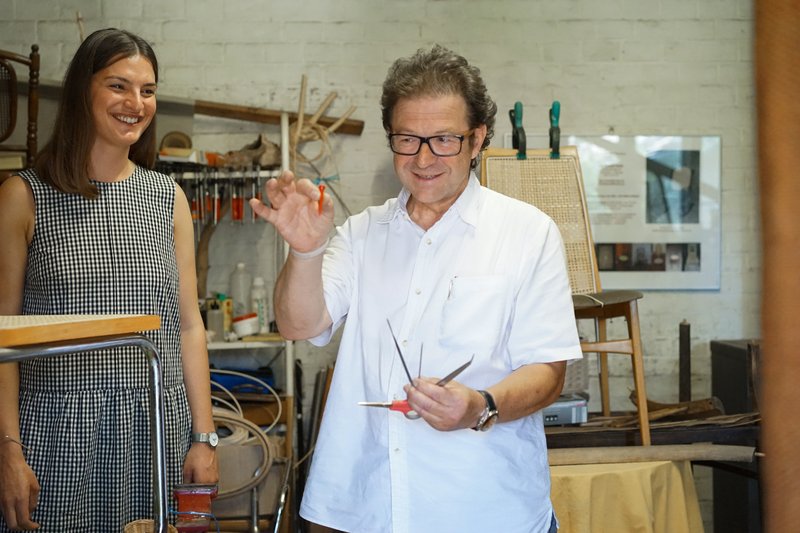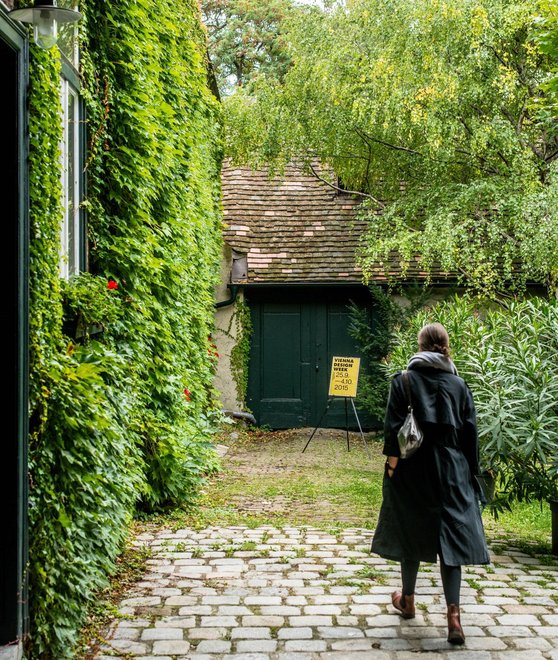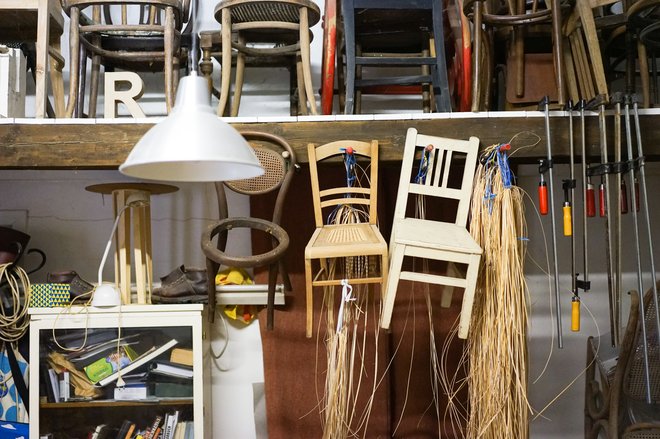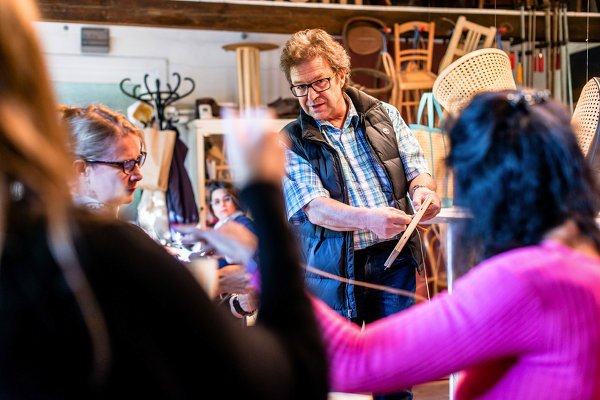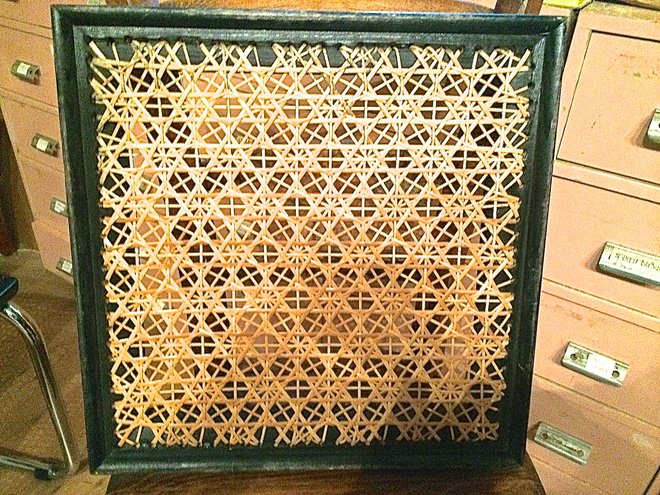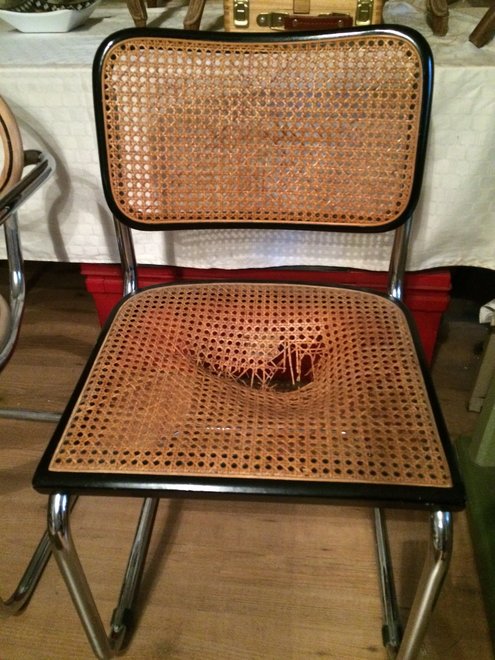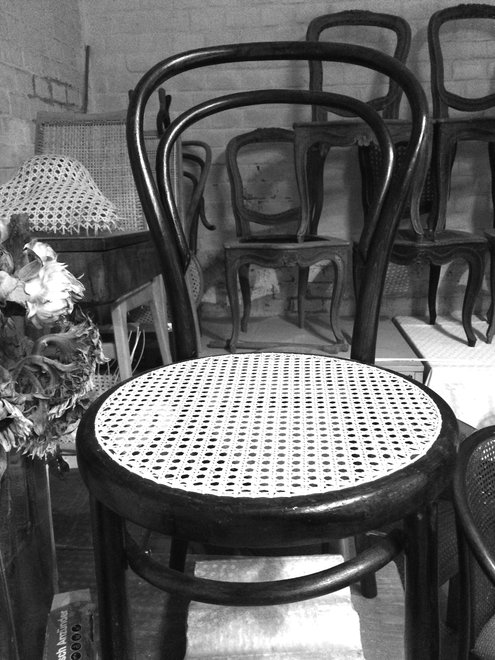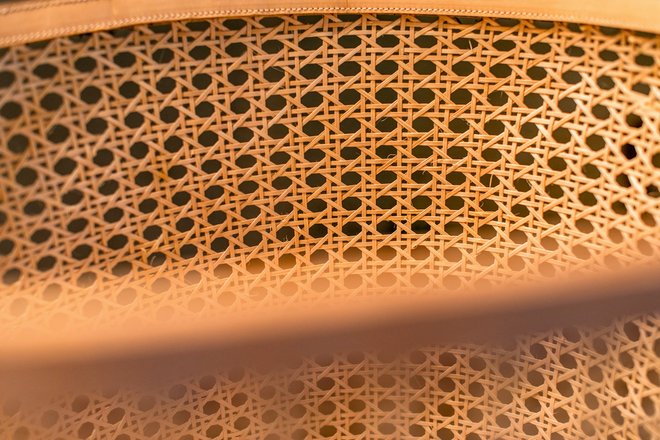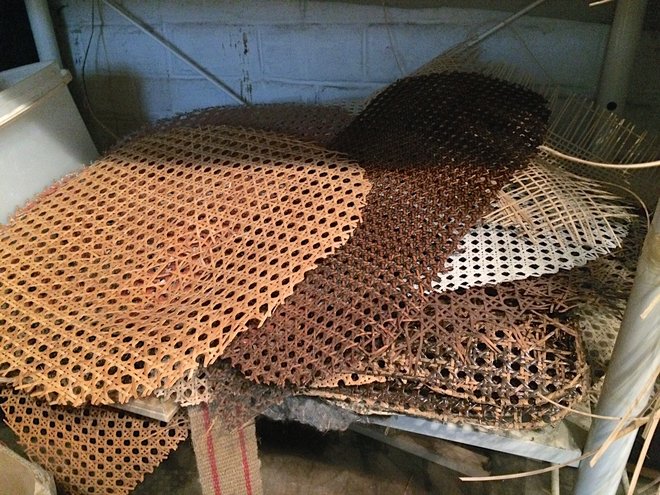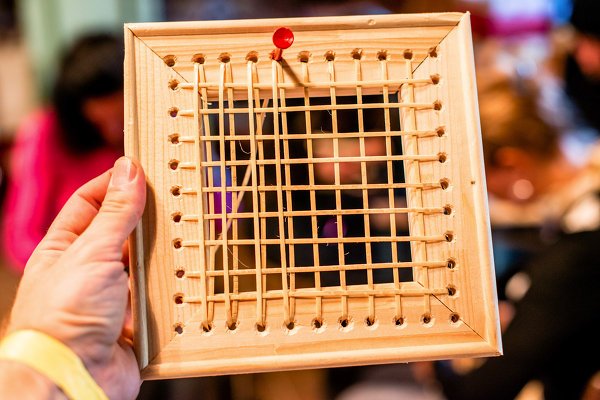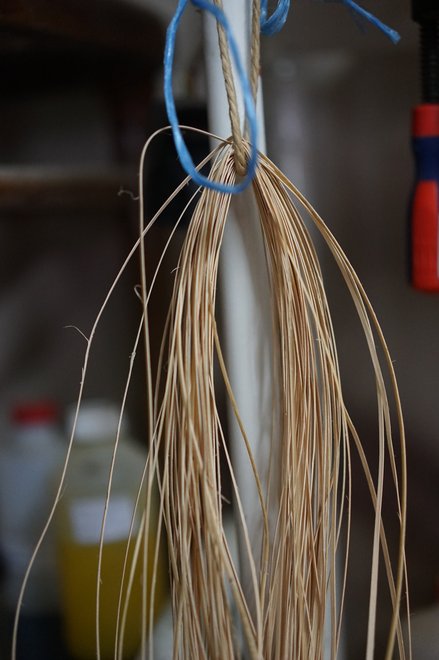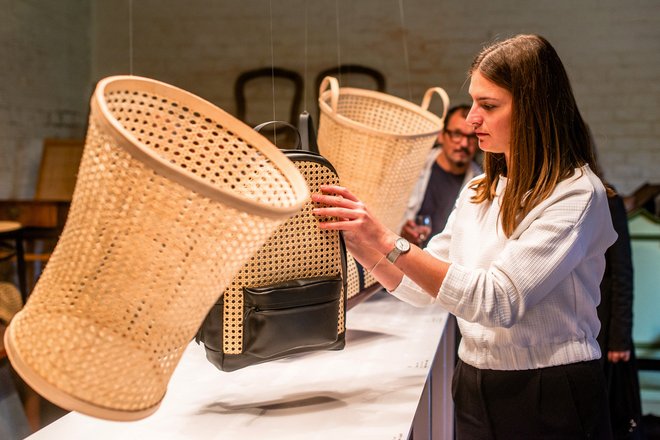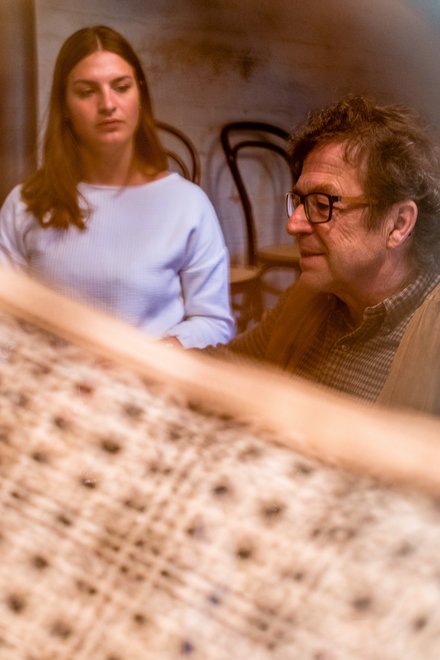Robert Roth is one of the few people in Vienna who master the craft of cane weaving and the so-called “Wiener Geflecht”, a special Viennese canework technique. He has already restored chairs by designers like Thonet, Marcel Breuer, Mies van der Rohe, or Josef Hoffmann. In his cozy workshop he told us who should better not sit on a cane chair and how he makes sure that his handicraft doesn’t die out.
A trip to Oberlaa. A stop over in the wine tavern “Mostquetsch’n” precedes my visit to Robert Roth. Then I walk by some two-story houses and tall chestnut trees. A village idyll on the southern periphery of Vienna. On the last stroke of the church bell I arrive at Robert Roth’s house. He already awaits me at the gate. The former farmhouse of his great grandfather accommodates Roth’s workshop. It is a beautiful green refuge with stacks of firewood and old brick walls behind vine tendrils. Outside it is cool and rainy, inside, in the workshop, comfortably warm, the wood crackles in the fireplace. All around there are piles of broken chairs.
Stephanie Rugel: You are an architect and have worked in this profession for a long time. Why did you quit your original job to become a self-employed seat weaver?
The understanding of the profession of an architect has changed. The architect used to represent the interests of the client toward the builders and was the creative head of a project. Today, people play off architects against one another – the cheapest one gets the commission, or even worse: they let them make the designs and take them directly to the builders.
"Without seat weaving this furniture is worthless."
So you don’t like that?
No. I’ve always been interested in old furniture, and at some point I did a cane weaving course at Schlierbach Monastery in Upper Austria. My teacher there immediately said I was talented. So that just matched up – my troubles with architecture and weaving as my hobby. I registered the business ten years ago.
Meanwhile, you have restored design classics by Thonet, Marcel Breuer, Mies van der Rohe, or Josef Hoffmann, you renewed and repaired their canework, to be precise…
Yes, there are even Thonet chairs which are almost 150 years old. These pieces of furniture are passed on within families and some collect them because of their love for old things. It’s a blessing that I am entrusted with these antiques so that I can contribute my mite.
But once you retire, who will do it then?
I won’t be there forever, so that’s why there must be people who master the craft of cane weaving in the future. That’s the main reason why I teach courses (see link to the courses at the end of this interview – editor’s note). Without seat weaving this furniture is worthless. It needs a person who can repair it.
How many weaving patterns do you master?
My specialty is the “Wiener Geflecht”, that’s what my clients ask for the most. But there are all kinds of different ones.
Robert Roth gets an old wooden frame from his storage and shows me a beautiful star-shaped weaving pattern (editor’s note).
Look, that’s what I’ve been trying out, too. This is the so-called “diamond weave”; it comes from England where it was very popular for garden chairs. It’s also called “Star of David weave” because of the typical star pattern. It has nine layers and is crafted from rattan fibers with different thicknesses. This is not suited as a seating surface, although it can bear some weight, but it’s better as a backrest.
My favourite is the Thonet Rocking Sofa No. 7400 from the 1904 catalog.
Right beside me I discover a chair with squares woven into one another and ask what it is.
This is a Far Eastern weaving technique, also not a magic trick. I’ve already done that, too. Just today I picked up these two chairs; they don’t have a “Wiener Geflecht” either, rather a paper weave. Here, the creative task is to first find the right type of cane cord. The chairs come from the United States. I did some research but haven’t found out yet which architect or designer they are by or who manufactured them.
How long do you take for a chair with “Wiener Geflecht”?
About one-and-a-half to two days, depending which mood I am in and how easily the task is going.
Do you sometimes practice by braiding your wife or friend’s hair?
Oh no! Braiding has nothing to do with it (laughs).
Which materials do you use for weaving?
For the “Wiener Geflecht” you need the bark of the rattan palm tree, a liana palm; it is peeled off and finely cut. This is done in Southeast Asia, and they come in various thicknesses. In principle, everything that is long and thin works (laughs), but the “Wiener Geflecht” has to be done with the “original” material. All other attempts failed, for example with vinyl tapes, as vinyl doesn’t withstand the sun – as soon as it shines on it the softeners evaporate and the material becomes brittle and breaks.
Over there is a broken chair with a hole in the seat. How many Esterhazy cream cakes can one scarf down before such a “Wiener Geflecht” bursts?
The canework doesn’t break that easily when you just sit normally on it. It can certainly last for 30, 40, or 50 years. Chairs are there for sitting – and not for hanging up curtains or screwing in light bulbs (laughs)!
Is there a limit for caned chairs when it comes to the weight of the users?
This makes me think of a story: A lady whom I’ve made chairs for came back after two years and complained: “They are all broken!” And I answered. “What do you mean, they are all broken? I’ve never had any complaints and yours are all broken? I must have had a very bad month then.” So I go to her and see her husband for the first time – he was 150 to 170 kilos. In this case, I want to say: When I’m that heavy I just don’t sit on a caned seat but on a wooden or leather arm chair. Until this experience I used to say: When you have enough space on a chair for sitting then nothing will happen. Well, I don’t say that anymore! (laughs)
Do you only sit on cane chairs at home?
(Laughs) No! That’s like the mechanic and the broken car: I have no time to repair my own chairs. I have a rocking chair in the living room and a few stools. But my house doesn’t consist only of cane chairs, I would have a problem with that: Having to deal with cane chairs all day and also sit on them at night – I would start dreaming of caning and get up in the morning just to see yet another cane chair (laughs)! Truth is, I like to get up and look forward to my workshop. That wasn’t always the case when I worked as an architect.
Do you have a favorite chair?
The Thonet Rocking Sofa No. 7400 from the 1904 catalog.
Apropos Thonet: Can you explain why the “Wiener Geflecht” or the Thonet chairs in general, which can be found today in almost every coffee house, were already so internationally successful back then?
I always compare this with today’s Ikea. The Thonets invented something that changed the entire furniture business – they made it possible to buy a mass-produced chair for relatively little money. Millions of these chairs have been sold around the globe. They were transported as individual pieces in shipping containers, which saved space as there was no airspace in-between the parts. When someone purchased furniture in this time, they would go to a carpenter and say: “I need a sitting room suite”, show drawings, and then it was manufactured. That was the standard practice in the Biedermeier era. But with Thonet it was like this: “Here is my catalog, please pick out what you want. How many pieces do you want of the chair?” Then he wrote the commission: 40 pieces restaurant seating. And in a blink of the eye, the delivery came with the next carriage. That was a revolution. It was comparatively cheap, and the chairs were light as well.
How do you work? Do you have someone who helps you? Do you listen to music while working?
I always work alone and listen to music – I like old jazz, Louis Armstrong & Co, but also classical music, Mozart, Beethoven, and classical contemporary music, when they play it on the channel Ö1. And in the afternoons I like to have ServusTV running in the background for the history or travel documentary programs – I wouldn’t have time for that otherwise.
In the framework of the project “Passionswege” by Vienna Design Week you joined forces with the designer Stephanie Hornig. Together you produced designs for bags and baskets. Your résumé of the collaboration?
This was, of course, a completely new experience because the designer had the idea to use the “Wiener Geflecht” in a new form. Not in a rigid frame how it is usually employed, rather softer and fringed with leather or textiles. It was a challenge for me to realize this idea. The whole thing was a developing process, and I had to think how to tackle this.
Tradition and zeitgeist converge in Stephanie Hornig’s products. She put the “Wiener Geflecht” in a new context. What’s your opinion on this?
(Answers hesitantly) Yes, you can do this… It’s just not that what is was originally invented for. But why not! I am a craftsman who deals with furniture and canework. That’s what it was invented for. After all, canework has this structure and look so that you can sit on it. A bag simply doesn’t have this functional requirement.
You have such a beautiful place here and a great, unusual profession. If, nevertheless, a good fairy hovered into the workshop, would you have wishes for her?
Not really, actually. I’m very satisfied with my life. I can fulfill my wishes by myself. For example, I just bought a new car, which I like very much. Moreover, I find it important to not forget to live instead of waiting for something.
What beautiful closing words. Thank you for the conversation!
Workshops at VHS Polycollege – Margareten/Wieden districts
Place: KunstHandWerk, Schlossgasse 23, 1050 Vienna
More info here

